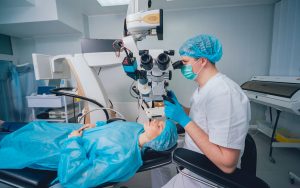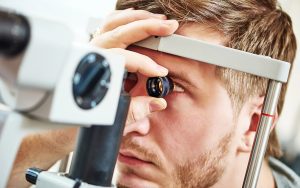Chalazion or Stye
[/vc_column_text][/vc_column][/vc_row][vc_row][vc_column][vc_column_text]Chalazion refers to a medical condition related to the meibomian or tarsal glands found in the eyelids of the eyes. These glands keep your eyes lubricated by periodically secreting an oily substance via outlets located under the eyelids, just past the eyelashes. This oily secretion traps a film of moisture over the eyeballs.When the ducts of a meibomian gland get blocked, the gland swells resulting in a small distinct lump on either the upper or lower eyelid called a chalazion or stye.
Causes and Risk Factors
A chalazion can occur due to one or more of several inflammatory conditions that directly or indirectly affect the eyes and skin, including:
- Conjunctivitis or Pink-eye
Conjunctivitis is the inflammation of the outermost layer of the eye, the conjunctiva, by an array of viral or bacterial species. These pathogens typically originate from other infections ranging from an ordinary common cold to STDs such as Gonorrhea and Chlamydia.
After infecting the conjunctiva, these viruses or bacteria can then find their way to the meibomian glands and cause chalazion. Furthermore, debris produced by physical irritation of the conjunctiva can also block meibomian gland ducts, causing a chalazion on the upper or lower eyelids. Physical irritants that cause pink-eye include shampoo,smoke, dirt, smoke, pool chlorine, eyedrops, pollen, fungi, and amoeba.
- Rosacea
Rosacea, a condition that is more common in women, is an inflammatory condition of the facial skin that does not have a viral or bacterial origin. However, this condition can affect the eyelids and cause abnormal enlargement of the meibomian or tarsal glands resulting in a chalazion.
- Blepharitis
Blepharitis, which is an inflammation of the skin over the eyelids, also occurs due to bacterial-induced conditions, such as boils, impetigo, cellulitis, strep throat, and pneumonia. The bacteria can then easily inflame the meibomian glands under the eyelids resulting in a chalazion.
- Diabetes
Elevated blood sugars levels, due to Type 1 and Type 2 diabetes, compromise the body’s innate ability to fight off bacterial and viral infections. The abundance of blood sugar provides viruses and bacteria with energy the pathogens use to replicate and invade body tissue.
As a consequence, any bacterial or viral infections affecting a person with diabetes can easily find their way to the eyes and inflame the meibomian glands causing Chalazion.
- Skin Cancer
While many of the pathogens mentioned above reach the eyes via hand contact, cancerous cells can travel through the bloodstream to the meibomian glands. These cancerous cells originate from regions of the skin affected by Melanoma, Basal Cell Carcinoma, and Squamous Cell Carcinoma. These cancerous cells can then cause a growth in the tarsal glands resulting in Chalazion.
Symptoms
The onset of Chalazion is marked by a small reddish area on the upper or lower eyelid. Within a few days, the inflammation develops into a visible lump on the upper or lower eyelid in one or both eyes. However, Chalazions typically form on the upper eyelid.
While a chalazion is often painless, the slow-growing lump continuously irritates the eyeball causing watery eyes. This occurs due to the excessive production of tears as the eye attempts to wash away the cause of irritation.
Furthermore, a chalazion that grows into a large lump can exert considerable pressure on the eye resulting in blurred vision.
Diagnosis
You can diagnose whether the small lump of your eyelid is a Chalazion or a stye by pressing on it. If you do not experience any pain while doing so, then the lump is likely a Chalazion. On the other hand, if intense pain manifests then the projection is likely due to a Staphylococcal infection such as Stye.
However, it is advisable to see an eye specialist to eliminate all doubts regarding a slow-growing lump on one or more eyelids. The physician looks for indicators of physical blockage by placing a finger underneath the eyelid, which exposes the meibomian gland ducts underneath.
Treatment
You can use home remedies to reduce swelling of meibomian or tarsal glands diagnosed as Chalazion. These techniques include:
Compressing the Chalazion using a clean cloth that has been soaked in mildly hot water. The heat from the compress helps to loosen any hardened oil within the tarsal glands.
Physically massaging the Chalazion using the tips of your fingers while applying gentle pressure. Doing so should not be painful and helps to force out any debris that may be blocking tarsal gland ducts.
However, you should see an eye specialist if your Chalazion for proper treatment. The physician typically prescribes a combination of steroidal anti-inflammatory medication and antibiotics to eradicate the Chalazion effectively. He or she can also surgically remove hardened oil from the tarsal glands if the lump resists non-invasive treatment.
Prevention
Consistent physical hygiene is your best bet at preventing the occurrence of Chalazion. This approach involves regular eye washing using warm water and mild soap. You should also avoid touching the eyes with the hands, especially if you have a bacterial or viral infection in other parts of your body. Finally, you should strive to protect your eyes when in an environment laden with physical irritants by wearing protective goggles while swimming in communal pools or when using power tools such as table saws, drills among others.
While Chalazion can be both unsightly and irritating, the condition is usually not painful. Regular cleansing of the eyes helps you to avoid the emergence of lumps in your eyelids. When the inevitable happens and you develop a Chalazion, you can always seek the services of an eye specialist to enable you to resolve the condition.[/vc_column_text][/vc_column][/vc_row][vc_row][vc_column][vc_empty_space][/vc_column][/vc_row]




